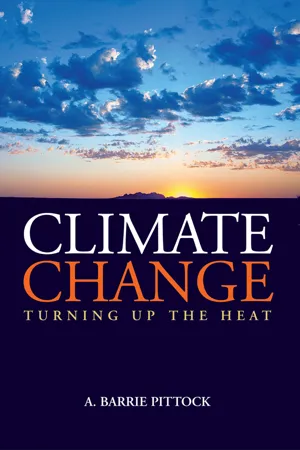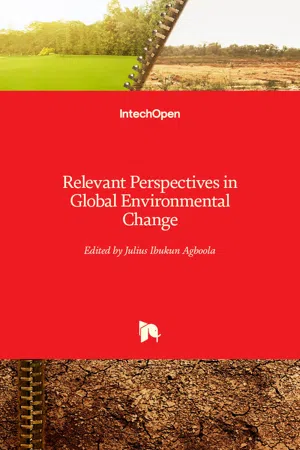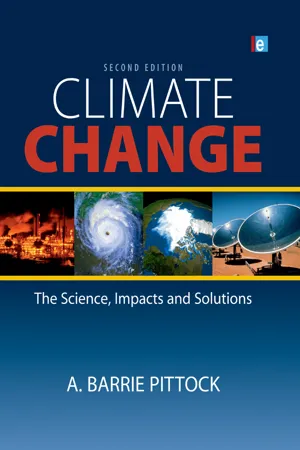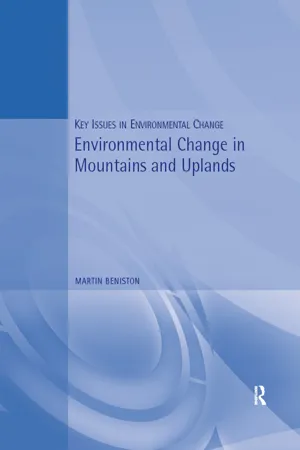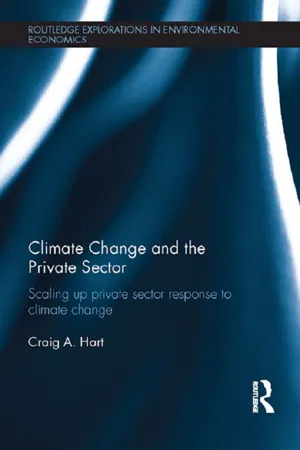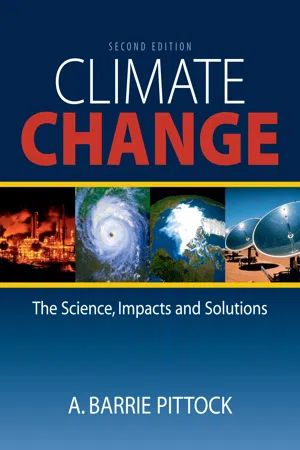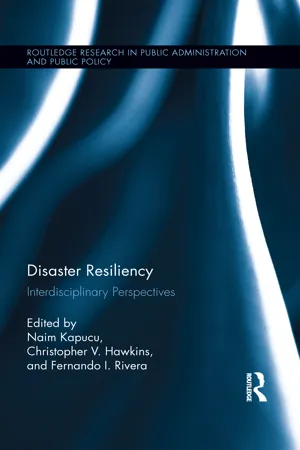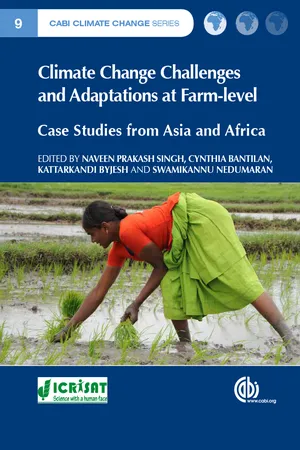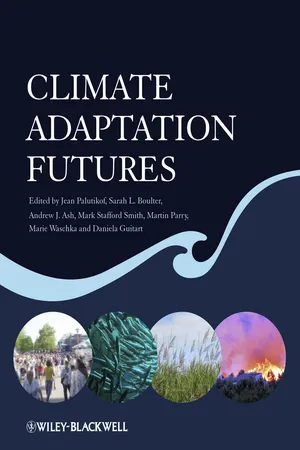Geography
Adaptation Strategies
Adaptation strategies refer to the actions and measures taken to adjust to the impacts of environmental changes, such as climate change or natural disasters. These strategies can include building resilient infrastructure, implementing early warning systems, promoting sustainable land use practices, and developing drought-resistant crops. The goal is to minimize the negative effects of environmental changes and enhance the ability to cope with them.
Written by Perlego with AI-assistance
Related key terms
1 of 5
11 Key excerpts on "Adaptation Strategies"
- eBook - ePub
Culture, Space and Climate Change
Vulnerability and Resilience in European Coastal Areas
- Thorsten Heimann(Author)
- 2018(Publication Date)
- Routledge(Publisher)
Alongside the systematic reappraisal and projection of the observed and potential impacts of climate change, Working Group II of the IPCC deals with adaptation measures for responding to these changes. The authors define climate adaptation as follows:The process of adjustment to actual or expected climate and its effects. In human systems, adaptation seeks to moderate or avoid harm or exploit beneficial opportunities. In some natural systems, human intervention may facilitate adjustment to expected climate and its effects.(IPCC 2014b: 5)The Working Group emphasises the relevance of climate and weather phenomena to human activity. The use of the word ‘adjustment’ indicates that climate changes may necessitate modifications of or breaks from previous routines. Adaptation measures are meant to either moderate or prevent harm or target potential opportunities. The dual reference to the possibility of interventions in ‘human’ and ‘natural systems’ hints at the variety of possible adaptation measures. Climate adaptation deals with both the currently observed and anticipated future phenomena interpreted as having an impact on climate change. Measures can be reactive (where pre-existing damage is perceived) or proactive (anticipatory) (Eichhorst and Madry 2013; Frommer 2010: 17).Chapter 3 already considered a variety of currently discussed climate-change impacts. The term ‘adjustment’ implies a reaction to this specific knowledge. The current study examines the spatial development of European coastal regions. Therefore, so as not to expand the scope of this study too far, it will be limited to the crucial problem constructions within the discourse, namely water-related challenges (such as sea and inland flooding), heat, and storms.4.3.1 Measures against sea and inland flooding: protection, accommodation, retreatWhen considering the challenges to coastal regions in Chapter 3 , it was revealed that several causes of flooding appear in the discourse. On the one hand, new formations of sea-water masses are regarded as posing a challenge to coastal regions, while the authors also identify new problems caused by changing inland water conditions (Knieling et al - eBook - ePub
Climate Change
Turning Up the Heat
- A. Barrie Pittock(Author)
- 2017(Publication Date)
- Routledge(Publisher)
Optimal Adaptation Strategies will only be adopted if there is a degree of foresight as to what is likely to happen and how it will affect people. Confidence is needed that the projected climate changes will occur, with understanding of possibilities and alternatives. Uncertainty can never be totally eliminated, so any strategy must contain an element of hedging one’s bets, by doing something that will be beneficial even if climate change does not happen quite as expected. Diversification is such a strategy. Agreement will also be necessary that the cost/benefit ratio for action is favourable, and the necessary human, economic and technical capacity to act must exist. If these conditions are not met, adaptation will be less than optimal. The first task in seeking optimal Adaptation Strategies is to become better informed.One example of successful adaptation, in the face of sudden climate change and great uncertainty, is that of the water supply authority for Perth in Western Australia (see Box 7 ). The best current explanation for the decrease in rainfall that occurred in the Perth catchments in the 1970s is that it was a combination of natural climate variability, the enhanced greenhouse effect and the effects of the depletion of ozone in the upper atmosphere. The circum-polar westerly winds have strengthened but moved further south, and the rain-bearing low-pressure systems have moved with them (see discussion in Chapter 1 ).A key problem in assessing the likely success of an adaptation strategy is judging how well the process is likely to be put into practice. This requires an understanding of the problem, and a conviction that adaptation is necessary and worthwhile. As in the Western Australian rainfall case, early acceptance that there may be a long-term problem rather than a short-term fluctuation is critical if large investments are needed. This requires good scientific understanding, and is not helped by unfounded scepticism or contrarian advocacy that confuses decision-makers and delays action.The degree and success of adaptation is a key factor in assessing likely climate change impacts. Early climate impact assessments often assumed that no adaptation occurred, thus exaggerating likely impacts. In the literature this is sometimes referred to as the ‘dumb farmer’ assumption. In some later impacts assessments the contrary assumption was made, that of perfect adaptation, or the ‘prescient farmer’ assumption. Obviously, the most likely situation lies somewhere in between, and will depend on effective provision of reliable information to the farmer, planner, industry or government agency. Well-targeted research, to address all relevant questions for the decision-maker in the local situation, is essential. Series of consultations or representation of interested parties on research and implementation panels is advisable, so that adaptation options are understood, relevant and supported by all parties. - Julius Ibukun Agboola(Author)
- 2011(Publication Date)
- IntechOpen(Publisher)
6. Global response “The scientific evidence is now overwhelming: climate change presents very serious global risks, and it demands an urgent global response” (Stern Review, 2007). Human perceptions Relevant Issues and Current Dimensions in Global Environmental Change 15 of the natural environment, and the way we use the environment, are socially constructed. The human responses are mitigation and adaptation. However, environmental problems must be addressed from a broader perspective that includes issues of impoverishment and issues of (in) equity, and recognizing the fact that “Space Matters”. In the context of global environmental change, it is important to consider the various spatial levels at which both environment and security concerns can be addressed. It is believed that these needs can be best met through an international research program that focuses both on guiding future research and assisting in policy development (at all levels). Given the severity of global environmental change impacts, various adaptation and mitigation measures are being used in the fight against climate change. The effective targeting of these measures across different sectors such as water, agriculture, tourism, infrastructure development and others requires the use of both practical and innovative strategies. Adaptation measures fall within a broad range, among others, from expanded water harvesting, storage and conservation techniques to the diversification of tourism activities. An example of an adaptation strategy to prevent damage from climate change is shore protection (e.g., dikes, bulkheads, beach nourishment), which can prevent sea level rise from inundating low-lying coastal property, eroding beaches, or worsen flooding. If the costs or environmental impacts of shore protection are high compared with the property being protected, an alternative adaptation strategy would be a planned retreat, in which structures are relocated inland as shores retreat.- eBook - ePub
Climate Change
The Science, Impacts and Solutions
- A. Barrie Pittock(Author)
- 2013(Publication Date)
- Routledge(Publisher)
Optimal Adaptation Strategies will only be adopted if there is a degree of foresight as to what is likely to happen and how it will affect people. Confidence is needed that the projected climate changes will occur, with understanding of possibi lities and alternatives. Uncertainty can never be totally eliminated, so any strategy must contain an element of hedging one’s bets, by doing something that will be beneficial even if climate change does not happen quite as expected. Diversification is such a strategy. Agreement will also be necessary that the cost/benefit ratio for action is favourable, and the necessary human, economic and technical capacity to act must exist. If these conditions are not met, adaptation will be less than optimal. The first task in seeking optimal Adaptation Strategies is to become better informed.One example of successful adaptation, in the face of sudden climate change and great uncertainty, is that of the water supply authority for Perth in Western Australia (see Box 7 ).5 The best current explanation for the decrease in rainfall that occurred in the Perth catchments in the 1970s is that it was a combination of natural climate variability, the enhanced greenhouse effect and the effects of the depletion of ozone in the upper atmosphere. The circumpolar westerly winds have strengthened but moved further south, and the rain-bearing, low-pressure systems have moved with them (see discussion in Chapters 1 and 5 ).A key problem in assessing the likely success of an adaptation strategy is judging how well the process is likely to be put into practice. This requires an understanding of the problem, and a conviction that adaptation is necessary and worthwhile. As in the Western Australian rainfall case, early acceptance that there may be a long-term problem rather than a short-term fluctuation is critical if large investments are needed. This requires good scientific understanding, and is not helped by unfounded scepticism or contrarian advocacy that confuses decision-makers and delays action.The degree and success of adaptation is a key factor in assessing likely climate change impacts. Early climate impact assessments often assumed that no adaptation occurred, thus exaggerating likely impacts. In the literature this is sometimes referred to as the ‘dumb farmer’ assumption. In some later impacts assessments the contrary assumption was made, that of perfect adaptation, - eBook - ePub
- Martin Beniston(Author)
- 2016(Publication Date)
- Routledge(Publisher)
Technological advances have generally increased adaptation options for managed systems. In terms of water resources, for example, these options include more efficient management of existing supplies and infrastructure, and institutional arrangements to limit future demands and to promote conservation. There is also a move towards improved monitoring and forecasting systems for floods and droughts, and construction of new reservoir capacity. In many mountain countries, effective land-use planning can help direct population shifts away from vulnerable locations such as flood plains and steep hillsides. However, many regions of the world currently have limited access to these technologies and appropriate information. The cost-effective use of Adaptation Strategies will depend among other factors on the availability of financial resources and the degree of technology transfer adapted to the end-user countries. Incorporating environmental change concerns into resource use and development decisions would be a manner by which Adaptation Strategies could become more efficient.Many of today’s anthropogenically induced environmental problems clearly originate in developed countries, either directly (e.g. greenhouse gas emissions which are leading to global warming) or indirectly (e.g. by delocalizing polluting industries from the rich countries towards the developing world). The basic principle of the FCCC is that the industrialized countries should take the lead in implementing appropriate measures to reduce the amplitude of climatic change and its adverse impacts. Economic growth, social development and environmental protection are interdependent and mutually reinforcing components of sustainable development, which is the framework for international efforts to achieve a higher quality of life worldwide. Responses to environmental change should be coordinated with social and economic development in an integrated manner. Any policy decision should aim at averting the adverse impacts of change, taking into full account the legitimate priority needs of developing countries for the achievement of sustainable development and the eradication of poverty. The FCCC, for example, notes the common but differentiated responsibilities and respective capabilities of all parties to protect the climate system. Specific commitments in the treaty relating to financial and technological transfers apply only to the 24 industrialized countries belonging to the Organisation for Economic Co-operation and Development (OECD). They agree to support climate change activities in developing countries by providing financial support above and beyond any financial assistance they already provide to these countries. - eBook - PDF
The Future of Philippine Agriculture under a Changing Climate
Policies, Investments and Scenarios
- Mark W. Rosegrant, Mercedita A. Sombilla(Authors)
- 2019(Publication Date)
- ISEAS Publishing(Publisher)
7 ADAPTATION AND MITIGATION STRATEGIES Marites M. Tiongco The United Nations Environment Programme has indicated that the most dangerous impacts of climate change could still be averted if rational and adequately financed adaptation and mitigation strategies are initiated to forestall disasters and migrations at unprecedented scales — but they must be applied immediately and aggressively. In the agricultural sector, adaptation and mitigation strategies primarily involve responses to higher temperatures, excessive precipitation, extreme weather events, rising sea levels, and the evolution of minor diseases and pest infestations into major ones. Resulting challenges include landslides, severe soil erosion, flooding, and drought, which in turn cause losses of crops, livestock, and fisheries; reductions in yields; shortages of water; and destruction of infrastructure (Table 7.1). Numerous strategies, technologies, and tools are available, but they need to be applied through coordinated and targeted approaches that respond to a complexity of locally specific conditions. Importantly, mainstreaming adaptation and mitigation strategies in agricultural development planning requires increased information and understanding about climate change and its implications, greater advocacy in the use of - eBook - ePub
Climate Change and the Private Sector
Scaling Up Private Sector Response to Climate Change
- Craig Hart(Author)
- 2013(Publication Date)
- Routledge(Publisher)
We begin with an overview of the adaptation challenge, describing the impacts of climate change and barriers to adapting to it. We then discuss systematic approaches to adaptation that could increase the effectiveness, and reduce the costs, of these efforts. Next, we focus on three key areas in which adaptation is imperative, urgent and highly complex – water, agriculture and health care. We conclude by discussing policies and strategies for leveraging private resources for adaptation. Chapter 6 further explores private sector approaches to adaptation by examining the use of financial instruments for risk management as a means to adapt to climate change. The adaptation challenge The Intergovernmental Panel on Climate Change (IPCC) defines adaptation as the “adjustment in natural or human systems in response to actual or expected climatic stimuli or their effects, which moderates harm or exploits beneficial opportunities” (Parry et al. 2007). As suggested by the IPCC's definition of adaptation, adaptation may occur both in physical as well as institutional systems, and takes account both of direct physical threats as well as of indirect consequences. Indirect consequences, such as changes in commodities prices, can concentrate and amplify various disparate influences, transmitting local conditions through global supply chains. The degree and type of adaptation that must occur depends on a region's vulnerability. For example, human settlements in coastal areas will face issues such as rising sea level and salt water intrusion, while many inland areas will experience increased heat at levels significantly higher than coastal areas. The IPCC describes vulnerability to climate change as a function of three components: exposure (including the character, magnitude and rate of climate change), sensitivity (degree to which a system is affected by climate change) and capacity to adapt - eBook - ePub
Climate Change
The Science, Impacts and Solutions
- A Barrie Pittock(Author)
- 2009(Publication Date)
- CSIRO PUBLISHING(Publisher)
It is argued by some that the best way to ensure adaptability is to increase resilience or the capacity to cope with natural year-to-year climate variability such as flood or drought years. This is true up to a point, but as climate change increases it will lead to extremes that are outside the limits of natural variability. In such cases ordinary resilience based on past climate variability may not be enough. Moreover, increasing resilience to cope with greater extremes will be uneconomic, or at least inefficient, unless guided by an understanding of the direction and magnitude of climate change. Increasing the capacity to cope with more tropical cyclones or hurricanes, for instance, does not make much sense if climate change is likely to lead to fewer tropical cyclones at that location. Thus, efficient Adaptation Strategies must be guided by an understanding of what to expect, that is, by informed foresight.Foresight is also needed for adaptation because most adaptations cost money and thus require investment, and because they take time to put in place. For example, adaptation to more severe storms may require changes to building design or drainage systems, and these are best made in the design and construction phase of buildings or other investments, not as retrofits later when the need is urgent and the cost is greater. Strengthening flood levees after the old ones have failed is too late.A handbook on methods for climate change impacts assessment and Adaptation Strategies has been developed by the United Nations Environment Program.3 The handbook discusses the principles and strategies for adaptation. These can be summarised in eight alternative but not exclusive strategies:- Bear losses . This is the baseline response of ‘doing nothing’. Bearing loss occurs when those affected have failed to act until it is too late, or have no capacity to respond in any other way (for example, in extremely poor communities) or where the costs of adaptation measures are considered to be high in relation to the risk or the expected damages. The big problem with this solution is that losses may become unbearable.
- Share losses
- eBook - ePub
Disaster Resiliency
Interdisciplinary Perspectives
- Naim Kapucu, Christopher V. Hawkins, Fernando I. Rivera, Naim Kapucu, Christopher V. Hawkins, Fernando I. Rivera(Authors)
- 2013(Publication Date)
- Routledge(Publisher)
Table 10.1 briefly describes a limited set of common strategies for mitigating damages from coastal erosion, storm surge flooding, and waves, plus a strategy specifically designed to accommodate accelerating sea level rise, rolling easements. We have classified these strategies into three categories of adaptive response to sea level rise generally following Dronkers et al. (1990): protect, accommodate, and avoid/retreat. While a number of other strategies can be considered (Grannis 2011; Titus & Craghan, 2009; van Raalten et al., 2009), this abbreviated set suffices for our demonstration.Drawing from the criteria that an array of scholars and practitioners have used to assess climate change adaptation and hazard mitigation alternatives (Bendick et al., 2010; Fankhauser et al., 1999; Fussel, 2007; Godschalk et al., 1998; Hill, 1968; Smith, 1997; Titus & Neumann, 2009; USACE, 2011), we apply eight goals for evaluating these strategies: minimize risk to human development; minimize public sector capital and operating costs; minimize opportunity costs of regulation; minimize interference with ecological adaptation; maximize flexibility to adapt as conditions change and new knowledge is gained; minimize legal challenges, i.e., account for federal and state constitutional and state statutory constraints; maximize political feasibility vis-à-vis costs, property rights, etc.; and mitigate environmental stresses including climate change.Several authors suggest relatively simple typologies for assessing the suitability of different adaptive response strategies for sea level rise. Titus et al. (2009) apply a heuristic typology based on existing and planned development intensity to prioritize the alternative responses of protection or retreat. They posit that communities are more likely to opt for protection against sea level rise as the mix of existing and planned land use shifts from areas dedicated to conservation and “vacant” land (e.g., agriculture or forestry) to higher levels of development intensity. Van Raalten et al. (2009) follow a similar approach in which they reduce the adaptive response decision framework to a four-cell “Strategy Development Method” matrix based on two primary values ascribed to a specific geographic area: (1) economic importance and intensity of existing development (high/low) and (2) natural hydrological and ecosystem dynamics (high-natural/low-altered). - eBook - ePub
Climate Change Challenges and Adaptations at Farm-level
Case Studies from Asia and Africa
- Naveen P Singh, Cynthia Bantilan, Kattarkandi Byjesh, Swamikannu Nedumaran, Naveen P Singh, Cynthia Bantilan, Kattarkandi Byjesh, Swamikannu Nedumaran(Authors)
- 2015(Publication Date)
- CAB International(Publisher)
This chapter introduces current and future climatic implication on national, regional and sub-regional agro-socio-economy. It focuses on the growing recognition of the climate change studies that are being considered inevitable. Authors argue that better understanding and assessment of adaptation and/or coping strategies at farm-level are prerequisite in the long-term development planning of the country or the region towards climate resiliency. The arguments were put forward to emphasize the vital link between agriculture, rural livelihoods and climate in the semi-arid tropics for the majority of the population in Asia and Africa. This chapter confines itself to various discourses on the past and present efforts on assessing impacts, adaptation and vulnerability to climate change particularly in the semi-arid tropics of Asia and Africa. It also discusses the global efforts on improving resilience against climatic risks in agricultural sector and also poor smallholder farmers of the semi-arid tropics. The chapter briefly reviews the current state of knowledge related to farmers’ strategies and determinants of decision in the choice of adaptation at farm-level. The chapter further discusses the organization of the book and also identifies potential uses of the book and the audience for whom this information is valuable.1.1 Introduction
Adaptation is a vital part of a response to the challenge of climate change; it is the only means to reduce the now-unavoidable costs of climate change over the next few decades. Sir Nicholas Stern, ‘The Stern Review’ on economics of climate change, October 2006Climate change is emerging as the biggest threat to livelihood sustainability of our times, posing an imminent danger to human security and the development of human capabilities. Until recently, the centre of attention has been on the actual or potential impact of climatic change and mitigation options. The focus is now shifting to the ways that different socio-economic groups are attempting to cope and adapt to climate variability in particular and climate change in general. International developmental agencies are inclined towards improving their understanding of climate change science, impacts and mitigation of climate change at the global and regional levels (ADB, 2009). This focuses on the growing recognition that, while climate change is inevitable, its effects can be largely extenuated with better understanding of adaptation and undertaking coping strategies.Global mean temperatures have been rising since the last century mainly owing to greenhouse gas accumulation orchestrated mostly by anthropogenic activities. The main causes are the burning of fossil fuels (coal, oil and gas) to meet the increasing energy demand together with intensive agricultural production and deforestation. Along with temperature, the climate itself is perceived to be continuously changing all over the world. Due to its adverse impacts, climate change has always been a matter of great concern to the farming, scientific and developmental communities. Climatic extreme events to gether with an increase in rates of change in climatic parameters could affect various sectors including water, agriculture, health, tourism, transport, energy and the like. The Human Development Report (2008) states that climate change is one of the greatest challenges humanity faces and/or will be facing, and it is considered the world’s most vulnerable population who are immediately at risk. In the future, the climate change associated impacts are imminent with the anticipated vagaries of the weather. According to the Assessment Report 4, AR4 (IPCC, 2007) the projected changes are summarized as follows: - eBook - ePub
- Jean P. Palutikof, Sarah L. Boulter, Andrew J. Ash, Mark Stafford Smith, Martin Parry, Marie Waschka, Daniela Guitart, Jean P. Palutikof, Sarah L. Boulter, Andrew J. Ash, Mark Stafford Smith, Martin Parry, Marie Waschka, Daniela Guitart, Sarah L. Boulter, Andrew J. Ash, Mark Stafford Smith, Marie Waschka(Authors)
- 2013(Publication Date)
- Wiley-Blackwell(Publisher)
The three case studies presented in this chapter have highlighted key challenges and barriers for adapting to climate variability and change, as well as provided insights into some of the conditions conducive to successful adaptation. Despite the different contexts, several common themes have emerged with regards to pathways for climate change adaptation. First, while individuals and households are able to develop multiple coping strategies, the case studies highlighted the importance of institutions and policies beyond the local scale for longer-term adaptation as they enable individuals and households to transcend the limitations of acting in isolation. Second, access to human and social capital, in particular cross-scale bridging and linking networks, emerged as a key way of adapting. Cross-scale networks linking the local to the national level are not only critical to facilitating household and community level adaptation (e.g. by providing greater access to resources) but also to enabling improved communication and more effective decision-making on climate change adaptation. All three case studies highlight the need for greater integration of findings and strategies emerging from community-based adaptation work into climate change adaptation policies developed at the regional and national levels. Third, the case studies have highlighted the need to unpack the concept of ‘community’ to recognise the different vulnerable and/or excluded subgroups within communities and their differences in access to resources, knowledge, networks and opportunities. Finally, based on these case studies we argue that successful adaptation to climate change is about adapting to multiple stressors and, in particular in these case studies, the management of a dominant stress, such as access to resources (including human capital, social networks, housing and financial resources). When planning for adaptation to climate change it is vital to recognise the difference in access to resources that households and communities experience: those experiencing poverty are often already in an adaptation deficit and thus have an even worse prognosis when it comes to further climate change. National policies need to recognise this adaptation deficit and the heterogeneity of the abilities of households and communities to adapt to climate change.
Index pages curate the most relevant extracts from our library of academic textbooks. They’ve been created using an in-house natural language model (NLM), each adding context and meaning to key research topics.

